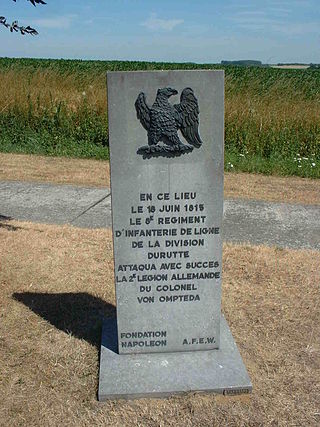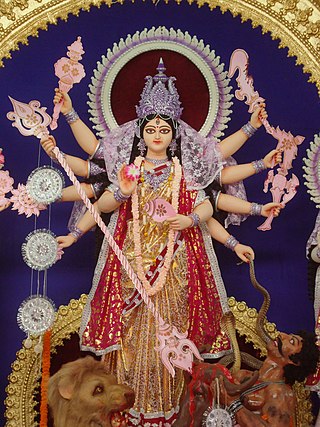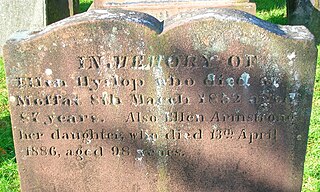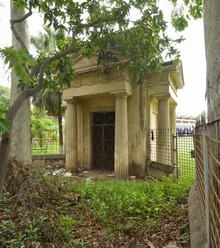
A headstone, tombstone, or gravestone is a stele or marker, usually stone, that is placed over a grave. It is traditional for burials in the Christian, Jewish, and Muslim religions, among others. In most cases, it has the deceased's name, date of birth, and date of death inscribed on it, along with a personal message, or prayer, but may contain pieces of funerary art, especially details in stone relief. In many parts of Europe, insetting a photograph of the deceased in a frame is very common.

A stele, or occasionally stela when derived from Latin, is a stone or wooden slab, generally taller than it is wide, erected in the ancient world as a monument. The surface of the stele often has text, ornamentation, or both. These may be inscribed, carved in relief, or painted.

The Bengal Presidency, officially the Presidency of Fort William in Bengal and later Bengal Province, was a province of British India and the largest of all the three Presidencies. At the height of its territorial jurisdiction, it covered large parts of what is now South Asia and Southeast Asia. Bengal proper covered the ethno-linguistic region of Bengal. Calcutta, the city which grew around Fort William, was the capital of the Bengal Presidency. For many years, the Governor of Bengal was concurrently the Governor-General of India and Calcutta was the capital of India until 1911.

The association of Armenians with India and the presence of Armenians in India are very old, and there has been a mutual economic and cultural association of Armenians with India.
Greeks in the United Kingdom are British residents and citizens of full or partial Greek heritage, or Greeks who emigrated to and reside in the United Kingdom.

Kolkata, India, is largely inhabited by the ethnic community of the native Bengalis respectively. According to a report by the Indian Statistical Institute owned by the Government of India, the Kolkata city had a population of 4.5 million as of 2011 out of which the population of native Bengalis in Kolkata is almost 62% which comprised the majority of the city's population, whereas ethnic groups like Marwaris, Biharis and Urdu-speaking Muslims together forming 36% of the population which comes under the category of large minorities. Other Various micro-minority communities of Kolkata include as far as concerned follows -: Pathans, Marathis, Odias, Gujaratis, Sindhis, Kashmiris, Punjabis, Nepalis, Telugus, Tamils, Anglo-Indians, Iraqis, Jews, Armenians, Tibetans, Greeks, Parsis, Chinese, and Iraqis etc.

Dhaka (Dacca) is a modern megacity with origins dating to circa the 7th century CE. The history of Dhaka begins with the existence of urbanised settlements that were ruled by the Hindu Gauda Kingdom, Buddhist and Shaivite Pala Empire before passing to the control of the Hindu Sena dynasty in the 10th century CE. After the Sena dynasty, the city was ruled by the Hindu Deva Dynasty.

Shahbagh is a major neighbourhood and a police precinct or thana in Dhaka, the capital and largest city of Bangladesh. It is also a major public transport hub. It is a junction between two contrasting sections of the city—Old Dhaka and New Dhaka—which lie, respectively, to its south and north. Developed in the 17th century during Mughal rule in Bengal, when Old Dhaka was the provincial capital and a centre of the flourishing muslin industry, it came to neglect and decay in early 19th century. In the mid-19th century, the Shahbagh area was developed as New Dhaka became a provincial centre of the British Raj, ending a century of decline brought on by the passing of Mughal rule.

Khwaja Alimullah was the first Nawab of Dhaka. He was the founder of the Dhaka Nawab family.

The Nawab of Dhaka, originally spelt in English Nawab of Dacca, was the title of the head of one of the largest Muslim zamindar in British Bengal and Assam, based in present-day Dhaka, Bangladesh. The title of nawab, similar to the British peerage, was conferred upon the head of the family by Queen Victoria as a recognition of the first Nawab's loyalty and contribution to the social welfare activities.

The Armenians in Bangladesh were ethnic Armenians who lived in what is now called Bangladesh. Their numbers have gradually diminished and there are now no Armenians in the country.

Old Dhaka is a term used to refer to the historic old city of Dhaka, the capital of Bangladesh. It was founded in 1608 as Jahangirabad or Jahangirnagar, the capital of Mughal Province of Bengal and named after the Mughal emperor Jahangir. It is located on the banks of the Buriganga River. It was one of the largest and most prosperous cities of the subcontinent and the center of the worldwide muslin trade. The then Nawab of Bengal Murshid Quli Khan shifted the capital from Dhaka to Murshidabad in the early-18th century. With the rise of Calcutta during the British rule, Dhaka began to decline and came to be known as the "City of Magnificent Ruins". The British however began to develop the modern city from the mid-19th century.

The Dhaka Christian Cemetery is a graveyard situated in Wari, a district of the old town in Dhaka, Bangladesh. It was established by Portuguese traders in the 17th century and is still in use by members of the Dhaka Christian community. It contains two designated archaeological sites, the Columbo Sahib mausoleum and the tomb of Reverend Joseph Paget. Many of the oldest graves and mausoleums are in a state of disrepair and are being overtaken by unchecked vegetation growth and lack of maintenance, while other parts of the cemetery still see new burials taking place at regular intervals. It is open daily to visitors.

Helen Hyslop, also Nelly or Ellen Hyslop was a 'noted local beauty' in Moffat and a strong local tradition maintains that Robert Burns was for some time a great admirer of her and that she had an affair with him. A daughter, also Helen, is said to have been born as a result of this liaison. Parish records show that a Helen Hyslop, the mother of Burns's possible daughter, was born in the area in 1766, her parents being John Hyslop and Janet Howatson of Langholm.
The following is a timeline of the history of the city of Dhaka, Bangladesh.

Saint Demetrius-Balș Church is a Romanian Orthodox church located at 14 Decembrie 1989 Street, nr. 15, in Iași, Romania. It is dedicated to Saint Demetrius of Thessaloniki.

Saint George-Lozonschi Church is a Romanian Orthodox church located at 2 Cloșca Street in Iași, Romania. It is dedicated to Saint George and Saint Catherine of Alexandria.

The Church of St Mary is a Church of England parish church in Chadwell St Mary, Thurrock, Essex. The church is a Grade I listed building. Together with Emmanuel Church, it forms the Parish of Chadwell St Mary in the Diocese of Chelmsford.

The Gudarekhi monastery is a 13th-century Georgian Orthodox monastery in the south of Georgia. It is located west of the village of Gudarekhi, Tetritsqaro Municipality, in the Kvemo Kartli region. The monastery complex consists of the main hall church, a free-standing bell-tower, and ruins of various structures such as a palace, cells, chapels, wine-cellar, and stables. The church is adorned with medieval stone-carvings and inscriptions. The complex is inscribed on the list of Immovable Cultural Monuments of National Significance.
Mīrzā Lutfullāh Khān Tabrīzī, also known as Murshid Qulī Khān II, was an 18th-century administrator who served under the Nawabs of Bengal as the Naib Nazim of Jahangirnagar (Dhaka) and Orissa respectively. Lutfullah was also a calligrapher, as well as an author in the Persian language under the pen name Sarshār.


















